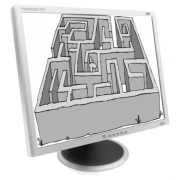The Attempt
There is "a realm of experience that is ruinous, where ceaseless pain suffocates the spirit and consumes the will to live. These are the moments of the suicide attempt: the 'whole catastrophe,' as Zorba declares. Here are all the feelings, thoughts, and actions at the threshold of suicide -- the extreme limit of one's ability and willingness to endure the pain and still remain alive. Suicide cannot be understood by isolating any one moment in the process. In order to explore the mystery of suicide, we must listen to all its voices; both its naked, unremitting pain and its cool and methodical planning. Important questions emerge: What frightful clash of internal and external forces would point one toward self-annihilation? What abandonment of hope could so challenge our basic innate instincts toward self-preservation?
As we listen to those who have decided to end their lives, we find some answers to these questions. Each story is different, and yet they all have significant commonalities. The story of suicide begins with loss or trauma, an unbridgeable sense of alienation, and a deep need to hide one's pain. Withdrawl begins and then deepens -- gradually, almost imperceptibly. Eventually, the person who was once here is no longer present ... she only goes through the motions of living. Hiding behind a facade, the person is isolated, and vulnerable to the urgings of the suicidal trance. Unchecked, the trance draws him or her to one fatal choice.
The Tunnel
And then I went to bed and thought that would be it. I remember lying there. The window looked out over the river and it was a beautiful scene. The moon was full and I was feeling this real peaceful- ness. I said to myself, 'It's a beautiful night to die.' I got into this whole other state, of knowing I was gonna die and accepting it and really wanting it. It's like when you go to weddings, you take pictures to remember everything that happened. Well, I was taking mental pictures to remember this.Chris
At the brink of the attempt, the suicidal trance intensifies to a frightening pitch. People feel extended beyond their capacity for survival. Some describe a deafening cacophony of voices, while others relate an otherworldly stillness and certitude. The suicidal act itself may be fraught with emotions of anger or grief, or it may be purposeful, even peaceful, and virtually without feeling. The ability to consider options has been so truncated [cut short] that the person sees his future as though through a narrow tunnel, at the end of which is only one possible outcome. Time exists only as the succession of moments between the present and this one final act.
Chris' experience of this tunnel was so intense that everything she thought and felt seemed to further confirm her desire to end her life. She was not to be thwarted, either by a change of heart of by outside intervention.
Chris' story vividly illustrates her paradoxical determination to wrest control of her life, by means of her death. It also reflects once again how traumatic loss, unacknowledged, may form the seeds of suicide... Chris and her husband moved back to the mainland, bought an old farmhouse, and tried to make a new start, but nothing changed. He continued to distance himself and assign blame, and she grew morose and pained. The grief of his rejection was omnipresent and consuming. For months on end, they would barely speak, occasionally being sexual --for him a release, and for her a momentary respite from loneliness. Curiously, Chris seemed incapable of expressing anger, as though those feelings were being consistently short-circuited, undermined by sadness. She had no experience at being assertive. Demanding basic civility seemed inconceivable, and her self-confidence eroded.
I would get this sinking feeling, like the bottom would drop out of my heart, and these thoughts and feelings that 'I don't deserve to live,' if I got angry at anybody. They could get angry at me, and I didn't like it much , but I cerainly couldn't reciprocate.
For almost all those I interviewed, there was a precipitating event that occurred just beofre the suicide attempt. A cursory look would lead one to belive that htis particular event caused the act, but the decision to end one's life rarely erupts so dramatically from one source of stress. A precipitating even appears in almost every recounting of an attempt, but shouldn't be regarded as teh real basis for it. Instead, the event serves to propel one further into the suicidal trance -- into the 'tunnel'.
The Attempt Itself
As people describe the details of their suicide attempts, we find that within the actual attempt to take one's life there exist smaller, highly powerful, and sometimes conflicting experiences. Just as a hurricane contains a number of discrete weather systems -- the ever- intensifying winds portending the storm's approach, the full malevolent force of the tempest unleashed, and the eye at its center (often so tranquil that one forgets the storm will soon resume its deadly course), a suicide attempt is composed of many different mind states. Each of them contains its own set of thoughts and emotions, and at any given point great sadness can exist side-by-side with a feeling of determination, and volcanic rage along with calm acceptance. Experiences within the suicide attempt include:
* Fury and rage
* The methodical trance, and
* Intimations of death
The Fury
The central moments in some suicide attempts are silent and methodical, but others are filled with an almost unearthly rage and desperation. All of the frustration, disappointment, and despair converge during a few explosive moments in which one's energy becomes directed toward self-destruction.
The Methodical Trance
Suicide attempts expressing strong emotion are dramatic and highly disturbing ... for many there seems to be no other outlet or target toward which to direct their emotion other than themselves. Suicide was the only channel they could find for their overwhelming rage. hearing their stories leaves us uneasey -- perhaps even frightened -- to ralize that internal and external pressures can escalate so precipitously.
It is surprising, however, that most people who attempt suicide experience relatively little emotion during the event. In fact, only a handful of those interviewed in this research said that there was a wild emotional tone to their suicide attempts. Instead, most spoke of a more methodical and purposeful demeanor, muted in emotion.
What allows one to become so nonchalant? Psychologists refer to this process as dissociation, in which people separate or distance themselves from painful or frightening emotions and memories, sometimes splitting them out of awareness together. This unconscious mechanism is quite effective as a temporary way of dealing with overwhelming stress or trauma. Over time, however, it leaves one's emotional life truncated [cut short] and shallow. The suicidal trance is an extreme example of this. It is as if there are two people present: one is in unbearable torment and the other is calculating the best way to eliminate the former and thus eliminate the agony. At worst, one may feel already dead, simply waiting for a final release.
Intimations of Death
"I'd know everything. I'd be delivered from confusion and learn the meaning of my life, the reason for my being here. All the questions would finally be answered."(Ian)
"I'd finally be with my family -- with the people who loved me."Robert
Images powerfully organize our lives. We entertain images of our possible future, and memories of our past, and both influence our experience of the present. We envision spiritually in the form of gods, saints, and angels. If we're honest, most of us will admit that we have imagined teh moments of our death.
As children, we wrestle with the incomprehensibility of death. "Will I still breathe?" "It must be cold under the ground." "Will Mommy and Daddy be there too?" "Do puppies go to heaven?" As we age, we may ask different questions and our concepts of death may be more complex, but we still wonder what this enormous event will bring. Both the questions and the answers come to us in pictures.
People who experience being close to death call upon the visions they've accumluatedd during their lifetimes, for they offer guidance. These images may encourage certain choices and may discourage others, but they are always central players in the drama of our own mortality.
This is especially true in the midst of a suicide attempt. Each person interviewed had a characteristic vision of an existence after suicide and a particular understanding of how it would provide the perfect response to suffering. For people in suicidal pain, as for many others, images of death offer respite and future reward. In the suicidal trancethe images of death as release and as an entry into a better world are so powerful and convincing that they can determine whether someone will continue to endure the suffering or will attempt suicide. Robert saw his death as liberation and deliverance: he would finally be free of those who didn't seem to love him and reunited with deceased members of his family who did. Mark, the painter and college professor, in his journal entry, envisioned death as the end of a life sentence of suffering.
Thus the need to affix the proper period to a life sentence that had become run-on. Back to the bathroom, blade in hand, turning the shower on quite hot. He felt a pulse in his ears, cauterizing the flow of forevers.
The Eye of the Hurricane
Suicide attempts promise a kind of certitude that those who suffer actually yearn for -- offering to end a life sentence of unceasing pain and to eliminate the daunting complexity of human existence with a single act. Suicide attempts create a sense of freedom in those who long for escape. People commonly report that at the center of their suicide attempts there were sudden moments of stillness: feelings of acceptance, serenity, and peacefulness, and relief from pain. How can calm be found in such an improbable context?
In these moments, when, like Abraham and Isaac combined, one is poised at teh altar as both executor and sacrifice, one expereinces a heightened state of awareness. One's attention is powerfully directed away from the trance and the chronic fixation on pain and is focused instead on the moment-by-moment experience of the present.
At this point people report being able to disidentify from the world of suffering and enter a new world that is smaller, less complex, and manageable.
Suicide promises to eliminate the possibility of continued hurt. In a series of perhaps inalterable moments, a person can sever his or her relationship with the world, declare an end, and feel relief that the war is over. He or she suddenly senses the serenity of nature or expereinces a clarity of perspective. One man I interviewed said, 'Everything came together. I finally felt clear. I knew this [suicide] was the answer.' On Robert's final walk to the hanging rope in the garage, although nervous, he felt filled with 'tranquility and peace'. Vic actually felt happy leaving his therapy group that night; and his ebulience carried him through most of the attempt. While Chris was being chased, she was twice able to experience the serenity of the full moon that would accompany her to her death. Throughout her attempts, she could feel the beauty of the night and the peacefulnes of the moment.
It was almost like a mystical experience, really. There was a very strange quality about it. I have made all these decisions to die, and it seemed there was this bigger energy around me. It was a kind of peacefulness. I could feel the coldness as well, but it was like this serenity descended into my brain. It made me think that I was making the right decision, you know, because right inside attempting suicide, I am experiencing this kind of very beautiful state.
These experiences are powerful. Paradoxically, they can even offer moments of appreciation for the sacred and precious beauty of life, despiet the fact that they are part of a suicide attempt. But they are ephemeral and short-lived. However potent, these experiences are still secondary to the intention to die, and they dissolve as the attempt continues.
At The Heart of the Attempt
What drives someone, in these final moments, to carry out his or her plan rather than interrupt it? What is the nature of the momentum that continues one forward, often despite considerable obstacles? The answer to these questions lies in at leaset one of the following desires:
* To escape a dilemma that feels inescapable
* To gain control of uncontrollable confusion
* To send a message when all other means of communication have failed, and
* To kill the pain, even if it means killing oneself
Escaping the Inescapable
I felt a relief. It was the only time I felt a little bit good during those twelve days. I really decided that that was it -- the only way I was going to relieve what I was going through. (Ed)
Human beings want to avoid pain. It is a natural and normal thing to do. We may decide to leave a job or to sever a relationship when it is chronically unsatisfying, or when it leaves us continually upset or feeling disconnected with ourselves. In some ways, the attempt to calm such turbulent waters is the same during a suicide. When the intensity is too great to bear and one sees no indication that change is possible, suicide seems like a reasonable attempt to escape what seems inescapable. Many who tell their stories describe a state of mind and body filled with turmoil adn chaos. Roiling waves of anger, fear, and self-hatred batter the mind until virtually nothing else can be sensed. The chaos that can assault from within and leave abject hopelessness.
People in difficult circumstances will often try to escape those circumstances by any route available. the amalgam of pain combined with the other elements of the descent brings them to a crossroads. One road represents the continuation of chronic suffering and the other represents liberation. However, their perception of available options is so narrowed at this point tha their only means of escaping the pain or quieting the chaos seems to be suicide.
Escaping the inescapable also reflects one's relationship with time. As we've heard, those who are suicidal conceive of their future as an immutable repetition of the present. Pain will compound pain throughout time, without respite.
Power and Control
People who contemplate suicide believe that their lives will never change for the better. They reason that it is futile to initiate any activity desinged to break through the crushing sense of defeat. They feel powerless. Backed against a wall or thwarted by an impenetrable shield surrounding them, they experience life spinning out of control, and their ability to stabilize it becomes progressively limited. It is paradoxical and tragic that, for many, the only act that can wrest a sense of power and control from such suffering is the attempt itself. The world must be simplified -- reduced to one moment, one certain destiny. Anything more is too complex to contend with. IN such a context, the phrase 'taking one's life in one's hands' means exercising one's last right of self-determination: the right to kill onself.
The Attempt to Communicate
After one has failed to communicate the depths of one's pain or the severity of one's fear and hopelessness, suicide attempts represent the delivery of a final message. We are familiar with the suicide note -- a good-bye left on the scene to be found after the act is completed -- but the attempt itself is also a message. Just as there are moments of fury within the attempt, and moments of desire to rescue a snse of power and control, there are also moments in which a person attempting suicide is consciously intending to send a message via the act.
Killing The Vehicle
At the heart of suicide lies the intention to kill the pain, regardless of the consequences. Whether it is unrelenting physical discomfort, or whether people have exhausted their capacity to bear overwhelming mental and emotional pain, they endeavor to extinguish the agony, utilizing whatever means necessary.
The attempt to kill oneself requires a substep that almost all those interviewed describe. In order to initiate the act and execute the plan dispassionately, one must first separate from the parts of oneself that are suffering. Again, dissociation plays a role. Since the body and mind are the vehicle through which one experiences unbearable pain, the body and mind become the targets of self-destruction. It seems logical to eliminate the pain by eliminating the vehicle.
This form of dissociation is most often a gradual process. However sudden it seems, however surprised others find themselves in the face of a loved one's attempt, the seeds have been sown before.
The Bubble Bursts
How are suicide attempts thwarted? What series of events intervenes unannounced to preserve one's life, and what happens then to one's suicidal trance? These questions take us into critical moments of the suicide attempt and those that immediately follow it. There are people for whom the attempt fails and yet the trance adn the desire to end their lives remain. Others experience the beginnings of a change, either during or just after the harrowing episode they orchestrated. Devotion to the suicidal quest wanes, but it leaves a vacuum. How that vaccum is filled strongly influences the trajectory of one's recovery.
There are people who, alarmed by unexpected physical distress -- increased or irregular heart rates, uncontrollable muscle spasms, shortness of breath, extreme loginess -- have abandoned the attempt and called for help. Others ... experience disturbing metaphysical encounters -- premonitions of death or afterlife, for example -- and stopped. Some gave up when the method faltered, as for example, when their bodies rejected the pills they had taken.
Sometimes the suicidal trance shatters during the attempt. The desire to die dissolves, at least temporarily, leaving the person shaken and unsure how to proceed. When the suicidal bubble bursts, people may feel overwhelmed with emotions they have long suppressed. The attempt seems to have organized all their thoughts and feelings into a vision of death and liberation, so that when the trance collapses, no psychological structure remains to handle the emotion.
Sometimes the failure of an attempt bursts the bubble of the suicidal trance. Most often, it delivers one into another state of confusion, a netherworld where people are neither strong or focused enough to make another attempt nor clear enough to envision the future. Sometimes just after an attempt, however, a glimmer of insight does emerge.
 The source for this page was Chapter 3, "The Attempt" of the book "Waking Up Alive". Click
below to purchase your very own copy of this book.
The source for this page was Chapter 3, "The Attempt" of the book "Waking Up Alive". Click
below to purchase your very own copy of this book.
Waking Up Alive: The Descent, The Suicide Attempt and the Return To Life by Richard A. Heckler, PH.D.
- Brother To Brother
- Personal Experiences of Those Who've Attempted Suicide Coming Soon
- Glenna and David Romph don't understand why their son took his life
- Glenna and David Romph's Letter To Local Newspaper
- Despair hits hard during holidays
- What families can do to help
- WLU brings suicide into open
- Links Related to Suicide Prevention
since December 23, 1999


This page was moved to this domain on February 9, 2003 - and is © Soul's Self Help Central 1996-2005. © Borderlinepersonality.ca 2003-2007
Last up-dated January 19, 2007















